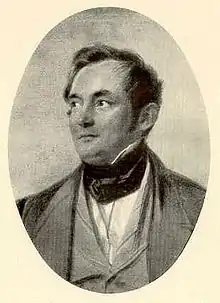Karl Adolph von Basedow
Carl Adolph von Basedow (28 March 1799 – 11 April 1854) was a German physician most famous for reporting the symptoms of what could later be dubbed Graves-Basedow disease, now technically known as exophthalmic goiter.
Carl Adolph von Basedow | |
|---|---|
 | |
| Born | 28 March 1799 |
| Died | 11 April 1854 (aged 55) |
| Nationality | German |
| Occupation | Physician |
Biography
Basedow was born in Dessau. He graduated from Halle University. He subsequently began general practice in Merseburg in 1822. He married early and became the town's chief medical officer, a position he would hold for the rest of his life. In 1840, Basedow reported on the conditions of what is now called Graves-Basedow disease. He died in Merseburg in 1854 after contracting spotted fever from a corpse he was dissecting.
Medical work
Basedow has three eponymous medical conditions: Basedow's coma, a thyreotoxic coma; Basedow's ocular syndromes, the unilateral retraction of the upper lid in Basedow’s syndrome; and, Graves-Basedow disease, a disorder characterized by the "Merseburger triad": tachycardia, goitre, and exophthalmos. The term "Basedow’s disease" was suggested by Georg Hirsch in his Klinische Fragmente.
References
- Karl Adolph von Basedow at WhoNamedIt.com
- "European Thyroid Association - Milestones - Carl Adolph von Basedow (1799 – 1854)". Retrieved 7 December 2012.
Mark Family (descendants of Karl)